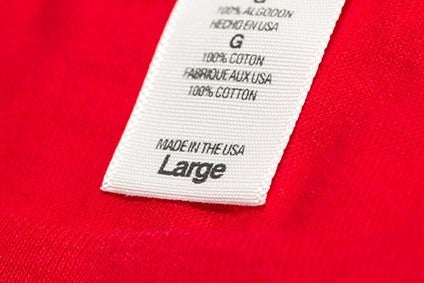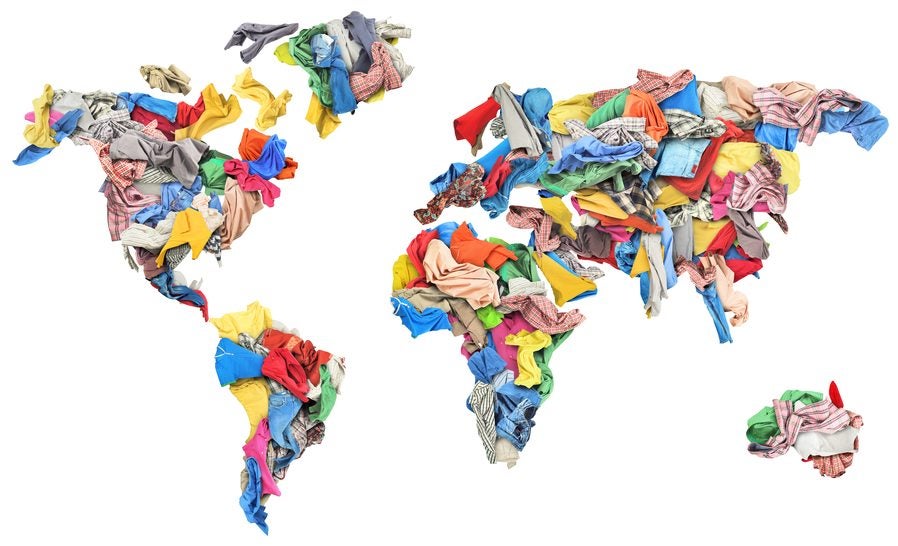
Anecdotal evidence suggests ‘Made in the USA’ clothing is growing in popularity – but there’s little insight into who’s selling it, what products are available, and the pricing strategy. In this detailed analysis, Dr Sheng Lu, associate professor in the Department of Fashion and Apparel Studies at the University of Delaware, crunches some numbers on the US retail market to find out more.
While the majority of apparel consumed in the United States comes from overseas, clothing ‘Made in the USA’ is growing in popularity. According to the ‘2018 US Fashion Industry Benchmarking Study’ released by the US Fashion Industry Association (USFIA) last year, around 46% of the US fashion brands and apparel retailers surveyed said they sourced ‘Made in the USA’ products – even though local sourcing typically accounts for less than 10% of their total sourcing value or volume.
Likewise, the State of Fashion 2019 report published by McKinsey and Business of Fashion (BOF) in November also forecasts that over 20% of US fashion companies’ sourcing volume could be from nearshore sources by 2025, thanks to increased automation in production and consumers’ growing demand for speed to market.
However, when it comes to ‘Made in the USA’ apparel in the US retail market, there is little insight into who is selling it, what products are available, and what the typical price range is.
To shed light on these questions – which are of strong interest to sourcing executives – we analysed the pricing, product assortment and inventory information of over 90,000 fashion retailers and 300,000,000 fashion apparel products at the stock-keeping unit (SKU) level based on data from real-time retail analytics firm EDITED.
How well do you really know your competitors?
Access the most comprehensive Company Profiles on the market, powered by GlobalData. Save hours of research. Gain competitive edge.

Thank you!
Your download email will arrive shortly
Not ready to buy yet? Download a free sample
We are confident about the unique quality of our Company Profiles. However, we want you to make the most beneficial decision for your business, so we offer a free sample that you can download by submitting the below form
By GlobalDataThe research focused on apparel products launched on the US market in the 12 months from 1 December 2017 to 30 November 2018, with ‘Made in the USA’ explicitly mentioned in the product description.
Who is selling ‘Made in the USA’ apparel?
Note: New products launched between 1 December 2017 and 30 November 2018 at the SKU level.
During the 12-month period, 94 out of the total 348 retailers (or 27%) sold ‘Made in the USA’ apparel in the US market. As shown in Table 1, the top 10 sellers list includes BOTH retailers that focus on the value market such as Walmart, and relatively high-end department stores such as Bloomingdale’s and Saks Fifth Avenue. However, even for these top sellers, ‘Made in the USA’ apparel accounted for less than 8%, on average, of their total product offers. This result, which echoes the findings of the USFIA benchmarking study, suggests ‘Made in the USA’ apparel overall is treated as a niche product in the sourcing portfolios of US fashion brands and retailers.
What ‘Made in USA’ apparel products are available in the market?
Note: New products launched between 1 December 2017 and 30 November 2018 at the SKU level.
When broken down into detailed product categories, US fashion brands and retailers have adopted very different assortment strategies for apparel ‘Made in the USA’ and imported.
As illustrated in Table 2, during the past 12 months, ‘Made in the USA’ apparel is more visible for fashion-oriented items, particularly bottoms (such as skirts, jeans and trousers), dresses, all-in-ones (such as playsuits and dungarees), swimwear and suits-sets. The competitive edge for these products increasingly depends on unique designs, high product quality, and speed to market – which makes sourcing from the US commercially beneficial. In comparison, imported products are more concentrated on basic fashion items that often compete on price, including tops (such as T-shirts and polo shirts), underwear and nightwear.
It is also interesting to note that ‘Made in the USA’ apparel is predominately women’s wear (92%), whereas imported clothing has a more balanced gender combination (63% women’s wear and 37% men’s wear). Because fashion trends for women’s wear are usually shorter-lived and harder to predict, this result once again indicates that seeking quick response and shorter lead times for stylish and trendy items could be an important incentive for local sourcing by US fashion brands and retailers.
What is the pricing strategy for ‘Made in the USA’ apparel?
Consistent with common perceptions, ‘Made in the USA’ apparel overall is pricier than imported garments in the US retail market.
Note: New products launched between 1 December 2017 and 30 November 2018 at the SKU level.
As shown in Table 3, taking the US apparel retail market as a whole, close to 40% of the ‘Made in the USA’ offering in the 12 month period targeted the premium or luxury market – compared with only 20% of imported products. In contrast, as few as 18% of ‘Made in the USA’ offer was in the value market – although this accounted for around 60% of all imported apparel sold. In total, it seems US fashion brands and retailers are purposefully targeting ‘Made in the USA’ apparel for less price-sensitive segments of the market to balance high domestic production costs.
On the other hand, at the product level, ‘Made in the USA’ clothing was still priced much higher than imported garments for almost all major categories except hosiery (Tables 4a and 4b). Notably, in the past 12 months, the average unit retail price of ‘Made in the USA’ clothing was 99.2% higher than imported garment in the value and mass market; and 36.0% higher in the premium and luxury market. This interesting phenomenon supports the argument that US consumers are willing to pay a premium price for products with the ‘Made in the USA’ label.
Additionally, during the past 12 months, around 46.3% of ‘Made in the USA’ apparel was sold at a discount compared with more than 54.6% of imported garments. The advantage of proximity to market – which enables speedy replenishment of in-season items – is also an important factor in the control of markdowns. For example, data shows that US fashion brands and retailers replenished approximately 12.7% of their ‘Made in the USA’ offering in the past 12 months, but only 2.8% of imported clothing.
Note: New products launched between 1 December 2017 and 30 November 2018 at the SKU level.
In conclusion, the findings concur with the view that ‘Made in the USA’ apparel is still relevant today. Moreover, it does not seem to be the case that apparel ‘Made in the USA’ and imported are necessarily competing with each other in the US retail market.
With apparel sourcing increasingly requiring a balance across various factors ranging from cost, flexibility, compliance to speed-to-market, ‘Made in the USA’ apparel should continue to have a unique role to play in the merchandising and sourcing strategies of US fashion brands and retailers.








